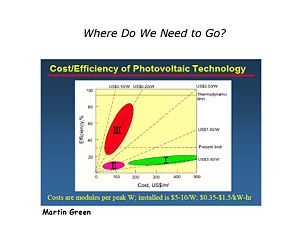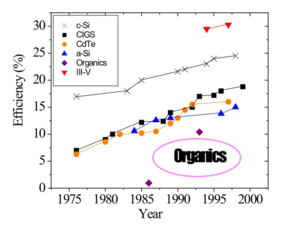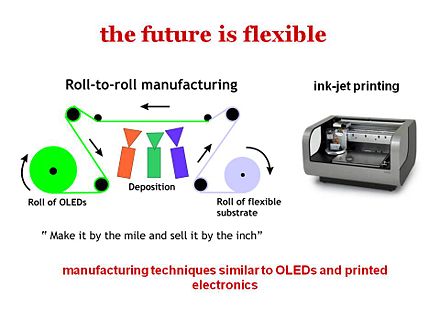Difference between revisions of "Solar Technologies"
| Line 24: | Line 24: | ||
=== First Generation Solar Cells === | === First Generation Solar Cells === | ||
Solar cells on the market now are almost "Generation I" devices, made out of crystalline silicon, considered to be a "mature" technology. they are somewhat expensive to produce because of the high processing costs needed to create silicon cells with sufficient purity and long range order. Generation II materials are less mature as a PV technology, are generally deposited from vacuum or by chemical vapor deposition (CVD), and include CdTe or copper-indium-gallium-selenide (CIGS) technologies. Their costs are lower, as are their efficiencies, but they can be created in much thinner, light weigh formats versus silicon cells. Disposal at end-of-life is a consideration, because of the toxicity of Cd, Te, Ga, and Se, and because of concerns regarding their "earth abundance." | |||
See DOE report on solar energy research<ref>http://www.sc.doe.gov/bes/reports/files/SEU_rpt.pdf</ref> | See DOE report on solar energy research<ref>http://www.sc.doe.gov/bes/reports/files/SEU_rpt.pdf</ref> | ||
=== Third Generation Organic Solar Cells === | === Third Generation Organic Solar Cells === | ||
OPVs come in several different platforms, and offer the potential as light-weight, low-cost, flexible and easily scalable energy conversion platforms. Their mode of energy conversion is based upon formation of a heterojunction between a donor (D) and an acceptor (A) material, which can be two different organic dyes, a polymer and a small molecule, a polymer and an ensemble of semiconductor or oxide nanoparticles, and a host of variations on this theme. Examples of companies attempting to bring OPVs to market include Konarka and Plextronics: | |||
[http://konarka.com/ Konarka is one of the first commercial OPV products] | [http://konarka.com/ Konarka is one of the first commercial OPV products] | ||
[http://www.plextronics.com/index.aspx] | |||
==Solar Potential== | ==Solar Potential== | ||
Revision as of 15:11, 2 June 2009
| Previous Topic | Return to OPV Menu | Next Topic |
Although solar energy is a very small component of the overall sources of energy, the use of solar energy is growing significantly. But an exponential increase of the production capacity of the solar energy is still needed in order to satisfy the needs of energy.
Utilization of Solar Energy
A 42% annual growth rate of cumulative installed PV capacity has been fairly steady in recent years and been accompanied by a steady decrease of the price of solar modules (per watt), from nearly $100 in 1976 down to an average of $4. That trend is often referred to as the learning curve. In 2005, for the first time in history a total of over 1 GW (gigawatt) of power capacity was added, increasing the cumulative installed capacity to a value of 3.7 GW in established industrial countries. The greatest proportion was installed by Germany and Japan alone (85%).
"Generation I" (single crystal and poly-crystal silicon) solar cells may be found on roof tops, and in large power generating arrays around the world. The BOS (balance of system) cost is generally larger for totally off-grid applications because they require a storage device, today this is typically an array of lead-acid batteries. For houses or industries which are "on-grid" solar generated electricity can be distributed back into the electrical grid when there is an overproduction with respect to the needs of the user.
Organic solar cells (organic photovoltaics -- OPVs) are an emerging, "Generation III" technology, providing another light-weight option for "off-grid" applications (e.g. chargers for portable electronics). OPVs may eventually compete for power generation with Generation I on-grid devices, if their efficiencies and lifetimes are high enough, and their costs low enough.
Generations of Solar Cells
First Generation Solar Cells
Solar cells on the market now are almost "Generation I" devices, made out of crystalline silicon, considered to be a "mature" technology. they are somewhat expensive to produce because of the high processing costs needed to create silicon cells with sufficient purity and long range order. Generation II materials are less mature as a PV technology, are generally deposited from vacuum or by chemical vapor deposition (CVD), and include CdTe or copper-indium-gallium-selenide (CIGS) technologies. Their costs are lower, as are their efficiencies, but they can be created in much thinner, light weigh formats versus silicon cells. Disposal at end-of-life is a consideration, because of the toxicity of Cd, Te, Ga, and Se, and because of concerns regarding their "earth abundance."
See DOE report on solar energy research[1]
Third Generation Organic Solar Cells
OPVs come in several different platforms, and offer the potential as light-weight, low-cost, flexible and easily scalable energy conversion platforms. Their mode of energy conversion is based upon formation of a heterojunction between a donor (D) and an acceptor (A) material, which can be two different organic dyes, a polymer and a small molecule, a polymer and an ensemble of semiconductor or oxide nanoparticles, and a host of variations on this theme. Examples of companies attempting to bring OPVs to market include Konarka and Plextronics:
Konarka is one of the first commercial OPV products [1]
Solar Potential
A sun power generator is used to test the efficiency of organic solar cells. The sun power generator refers to the air mass (AM) 1.5 = Air Mass which also corresponds to the incident power of 100 mW/cm^2 or 1000 W/m. Questions like “What is the efficiency of your solar cell in terms of transforming that amount of power per cm^2 into electrical power?” come up often. This is referred to as one sun. The sun is considered a blackbody emitter.
Solar Spectrum
This green curve shows solar spectral distribution for one sun (the y-axis units on the right) for those standardized conditions. The dips in the bands are represent absorption by carbon dioxide and water in the atmosphere. These dips also account for reflectance back towards Earth, e.g. the greenhouse effect.
The black curve (y-axis on the left) represents the total current density that you have when you integrate from a wavelength of 0. The maximum current density can be calculated by counting all the photons starting from 0 wavelength on the high energy side. This the maximum current density that can be obtained if the power efficiency were to be 100%, or in other words, if for every photon that comes, one electron enters the electrical circuit. This represents a photocurrent 40 milliamps per square centimeter of solar cell area. A few OPVs have begun to approach this but efficiency is still a hot spot for research.
Advantages of Organic Photovoltaics
Cost Considerations
The major driver of new technologies is not only the lack of supply. If an alternative solution for sources of energy that is less expensive than fuel or electricity is found, then everyone will use it as long as the technology is available. However, as of now, that is not the case. The cost of electricity from coal fired thermal plants is about 4 cents a kilowatt hour while silicon solar runs about 25- 35 cents a watt. The price for alternative solutions such has solar cells is still pretty high. For instance, Allen Heeger[2] has installed a solar cell roof on his house in Santa Barbara but it will take about 7-8 years before it becomes profitable. However, that is still better than losing money from electricity costs every year for the duration or lifetime of the house. Metrics: What is most important in terms of the overall production is power conversion efficiency of single cell. With respect to the given input power of the sun, what is the electrical output power that the solar cell can produce? In our case, we will refer to this power conversion efficiency
An economic example: with 5 hours of peak sun per day, 10% conversion efficiency and 10 m2 (1 kW capacity), 5kWh/day, 150 kWh per month, 1,800 kWh per year would product $600 of electricity per year if $0.3 per kWh. The cost of a 1kW capacity system, $7/W, $7,000.
Calculate the Carbon footprint to charge an iPod
Efficiency
The record in terms of power efficiency for a single cells on the order of 25%. If cells are stacked up with one on top of the other, the power efficiency can reach up to 40%. The material that can produce the best performance and has the highest power efficiency is the III-V. Crystal and silicon has an efficiency of 25% for a single cell. The organics that have started 20 years ago with the work of Xing Tai at Kodak are going up. For polymers, the record efficiency is on the order of 6%. In the case of the Gretal cells that are hybrid organic, inorganic, can have efficiencies of 11-12%. Usually there is too much emphasis on efficiency of the cell because that is certainly not the only parameter that needs to be taken into account in the engineering of the cell and in using it efficiently for the electrical grid. Many of these cells that produce a very high efficiency are also extremely small. Then when solar cells are scaled up to the sizes that are needed to cover a roof the scaling up will lead to issues that will lower the efficiency. So when someone gives you a new record efficiency always pay attention to what is the scale or the area of the cells they are using.
5% is considered a reliable efficiency for OPVs at this time. This low efficiency is tolerable if the production expense is small compared to silicon devices. At 10-11% OPV will become economically viable. This should be achievable within a few years.
Weight and Flexibility
Another reason many people have interests in organic solar cells is that flexible modules can be made. For example instead of separate panels, extremely thin conformable films can be used to cover the roof and the solar cells won’t make any visual impact on your roof. Also for many other applications, weight is an issue. For soldier in operations a very significant part of the weight that must be carried is from due to batteries and therefore, being able to have portable power that would be light weight would make a big difference. All these aspects stir great interest in making flexible organic cells.
Manufacturing and Disposal
Organic solar cells may be manufactured with easy to process plastics using standard screen printing techniques rather than the elaborate methods required with silicon solar cells. At end of life they will non-toxic and easy to dispose of.
External Links
Explanation of spincoating process
Video on on OPV manufacturing process
References
http://en.wikipedia.org/wiki/Vacuum_deposition
| Previous Topic | Return to OPV Menu | Next Topic |





